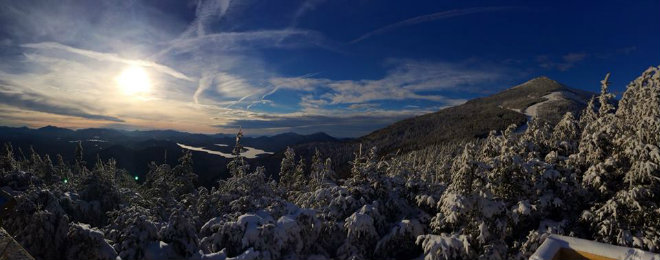Whiteface Ski Area
Whiteface is one of the East’s best ski areas. The base elevation of Whiteface is 1,200 feet (365 m) rising to the Summit Quad terminus at 4,386 feet (1,336 m), with the option to hike up to the Slides off-piste terrain at 4,650 feet (1,415 m) which offers 3,450 feet (1,050 m) vertical elevation and non-stop skiing back down to the resort.Whiteface Ski Terrain
Whiteface is perhaps best known as the venue for the alpine events at the 1980 Winter Olympic Games. By any standard, Whiteface is big mountain skiing, but the ski area is compact with 86 trails in just 283 acres. Unlike many resorts in Eastern North America which fudge their vertical drop numbers or whose topography prevent non-stop skiing from the top to the bottom elevation, Whiteface’s impressive vertical drop is both legitimate and continuous. Skiers can enjoy 3,450 feet (1,050 m) of non-stop skiing from the top of the Slides, Whiteface’s in-bounds backcountry area.
Whiteface offers skiing and riding from three connected summits: Whiteface, Little Whiteface and Lookout Mountain. Beginner and children’s skiing is also available at the Easy Acres Family Center near the base of the resort. The highest lift-accessed skiing is from the top of the Summit Quad, just below the summit of Whiteface Mountain. From here, the scenic “Follies” trail with excellent views of Lake Placid and the Adirondack High Peaks region is a popular choice for intermediates. If you’re feeling a little friskier, “Cloudspin” and “Skyward,” the trails that hosted the men’s and women’s Olympic downhill events, are Whiteface Mountain’s best advanced runs.
The bulk of Whiteface’s terrain is on Little Whiteface, though in reality there’s nothing little about it. Were Little Whiteface a separate, standalone resort it would rank in the top five for vertical drop in Eastern North America at just around 2,500 feet (762 m). It is serviced by the modern Cloudsplitter Gondola, installed in 2006, which carries skiers and riders to the Little Whiteface Peak, providing access to well-groomed intermediate and advanced terrain. A new triple chair has opened up Whiteface’s newest summit, Lookout Mountain. Already several trails and glades are in place and there are plans to expand even more in the coming years.
Despite boasting the largest vertical drop east of the Rockies, Whiteface also has a well-deserved reputation for being difficult, cold, and (more often than not) icy. Affectionately known to locals as “Iceface,” conditions on the exposed summits can often be less than optimal. Additionally, the resort is tall, but narrow. Visitors sometimes complain that they feel like they have skied the same trails all day, because most trails funnel into only one or two (substantial) runouts back to the lifts. This problem has been alleviated somewhat in recent years by the addition of the Lookout Mountain terrain, but low acreage translates into limited trail variety.
Whiteface Lift System
Whiteface has 11 lifts offering access to skiing and snowboarding terrain on three summits. Because three chairlifts and the eight-passenger Cloudsplitter Gondola load near the base area, it can often be congested during peak times.
Also, Whiteface is often affected by strong winds and the Cloudsplitter Gondola, Little Whiteface Double, Lookout Mountain Triple, and Summit Quad chairlifts can be closed during periods of sustained wind. The Cloudsplitter Gondola is particularly susceptible to wind delays. Whenever these lifts are not running, the Mountain Run Double and Freeway Double are your best bet. Avoid the Face Lift Quad, where lines build quickly when the gondola goes on wind hold.
Whiteface Boarding and Freestyle
The most advanced freestyle park area is Brookside Park accessible from the Face Lift. Brookside Park has the biggest jumps and longest rails on the mountain. Whiteface also offers freestyle terrain for beginners on the Bronze Trail at Kids Kampus where there’s a fantastic mini half-pipe and wide flat boxes designed for beginner skiers and riders.
Whiteface also has a mini-park and a boarder/skier cross course on Wolf and Wolf Run. The course is designed for all abilities with double and triple options for advanced cross riders and roll-over features for less experienced cross riders. The ski cross course and mini-park are serviced by their own chairlift – the Bear Chair.
Whiteface Pros and Cons
+ Long, uninterrupted vertical drop
+ The Slides off-piste terrain for advanced skiers
+ Olympic heritage and unsurpassed off-slope activities
– Often cold, windswept and icy
– limited beginner terrain












